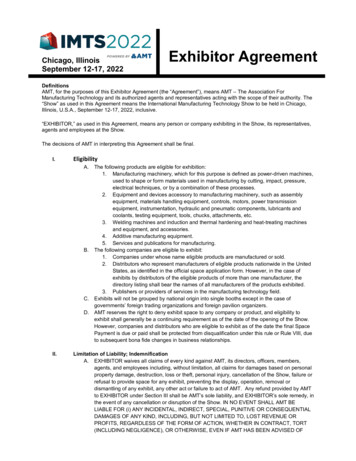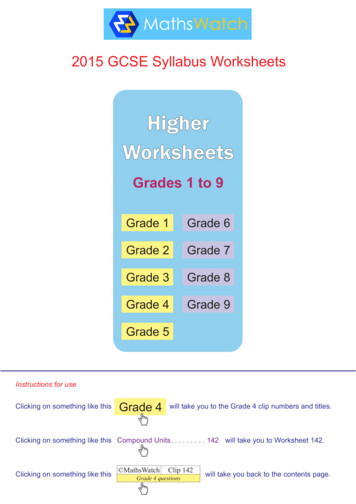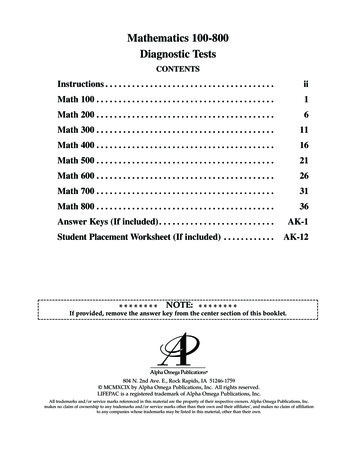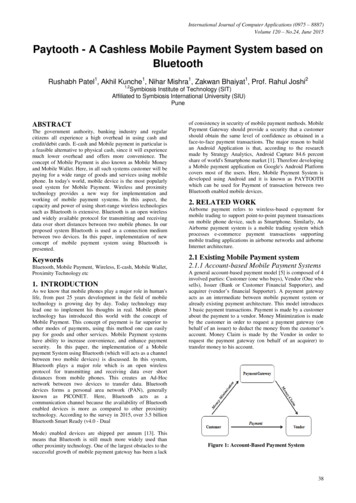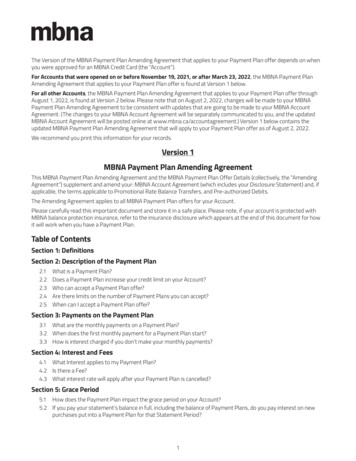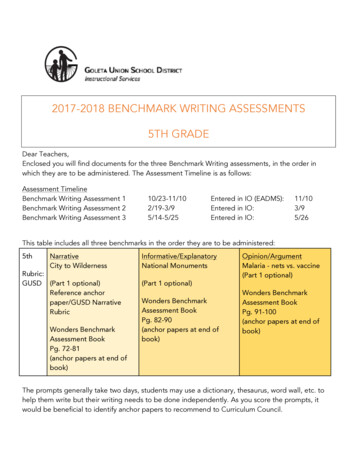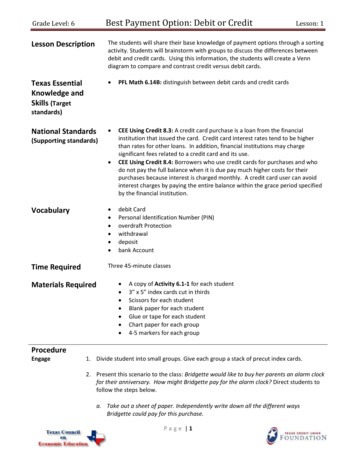
Transcription
Best Payment Option: Debit or CreditGrade Level: 6Lesson: 1Lesson DescriptionThe students will share their base knowledge of payment options through a sortingactivity. Students will brainstorm with groups to discuss the differences betweendebit and credit cards. Using this information, the students will create a Venndiagram to compare and contrast credit versus debit cards.Texas EssentialKnowledge andSkills (Target PFL Math 6.14B: distinguish between debit cards and credit cards CEE Using Credit 8.3: A credit card purchase is a loan from the financialinstitution that issued the card. Credit card interest rates tend to be higherthan rates for other loans. In addition, financial institutions may chargesignificant fees related to a credit card and its use.CEE Using Credit 8.4: Borrowers who use credit cards for purchases and whodo not pay the full balance when it is due pay much higher costs for theirpurchases because interest is charged monthly. A credit card user can avoidinterest charges by paying the entire balance within the grace period specifiedby the financial institution.Vocabulary debit CardPersonal Identification Number (PIN)overdraft Protectionwithdrawaldepositbank AccountTime RequiredThree 45-minute classesstandards)National Standards(Supporting standards)Materials Required A copy of Activity 6.1-1 for each student3” x 5” index cards cut in thirdsScissors for each studentBlank paper for each studentGlue or tape for each studentChart paper for each group4-5 markers for each groupProcedureEngage1. Divide student into small groups. Give each group a stack of precut index cards.2. Present this scenario to the class: Bridgette would like to buy her parents an alarm clockfor their anniversary. How might Bridgette pay for the alarm clock? Direct students tofollow the steps below.a. Take out a sheet of paper. Independently write down all the different waysBridgette could pay for this purchase.Page 1
Grade Level: 6Best Payment Option: Debit or CreditLesson: 1b. Take turns sharing your list with your group. As each person shares, one groupmember will write each payment method on the precut index cards. Write downeach payment option only one time, even if it was contributed by more than onegroup member3. Ask each group to share their payment methods by listing the methods on the boardsimultaneously. (Possible responses: credit card, debit card, cash, check, cashier check,and gift card) Allow groups to create additional cards with payment method if needed.4. Ask each group to sort the cards using any category. Using a blank sheet of paper havegroup draw a line down the middle. Write a heading on the top of each side of thepaper that describes how the cards will be sorted. (Possible methods of sorting: loanand non-loan or paper and plastic)5. Instruct the groups to explain the rationale for their sorting. Listen for understanding ofthese payment options and clarify any misunderstandings.Explore/Explain6. Distribute one copy of Activity 6.1-1 to each student. Tell the students that they aregoing to focus on credit cards and debit cards. Have them use the chart on Activity 6.11 to write everything their group knows about debit and credit cards. Then engage thestudents in a class discussion in which the groups share their knowledge as the teacherclarifies. Encourage students to record any additional information on their chartsduring the discussion. Use Key 6.1-1 as a guide.Explore/Explain7. Distribute a sheet of chart paper and 4-5 markers to each group. Direct students tocreate a Venn diagram that represents the similarities and differences between a debitcard and credit card. Students should use Activity 6.1-1 to find clues. [Note to teacher:If your students have not had a recent experience creating a Venn Diagram, considermodeling the process using a different comparison such as chicken and an eagle.]8. Once the Venn diagrams are complete, have students hang their charts. Direct groupsstand by their Venn diagram. Have each group explain their rationale for their model. Asample key is provided.Evaluate9. Have students take out a blank sheet of paper. Fold the paper in thirds to create a tabletent. Write credit card on one side of the tent and debit card on the other side. Theteacher will read the statements below. The student will display side of the tent thatrepresents the statement towards the teacher. If it is a characteristic of both cards, havethe students stand up. After each statement, ask students to justify their response.a. Money is withdrawn directly from a checking or savings account. (Debit Card)b. Each purchase is a loan that is repaid later. (Credit Card)c. Consumers can purchase items now and pay for them later. (Credit Card)d. Hefty fees may be charged if you spend more than what is in the account. (DebitCard)Page 2
Best Payment Option: Debit or CreditGrade Level: 6Lesson: 1e. Convenient to use. (Debit Card & Credit Card – There is no need to carry cash or acheck book.)f.A PIN (Personal Identification Number) is required to make a purchase. (Debit Card)g. Interest may be charged, but can be avoided by paying the entire balance eachmonth. (Credit Card – If you cannot pay your entire credit card balance eachmonth, try to pay as much as possible. The balance will decrease and you will payless interest over time.)h. If the card is lost or stolen, report it immediately. (Debit Card & Credit Card – It isimportant to report lost or stolen cards to prevent fraudulent purchases orunauthorized access to your account. Since this phone number appears on the backof the card, write the number down and keep it in a safe place.)i.j.Eric purchased a movie ticket with his card. This money will come straight out of hischecking account. What card did he use? (Debit card)Rosa’s gas pump went out as she was driving her car to work. Since she did not haveenough money to cover the cost to replace the pump, she used a card that allowedher to pay later. What card did she use? (Credit card)k. Mrs. Brady took her family out to eat. She handed the waitress a card to purchasethe meal. This charge appeared on a bill that she paid three weeks later. (Credit card)l.Evaluate/EndTo avoid carrying cash, Ned pays for his lunch using this card. Each time he uses thiscard his checking account decreases. (Debit card)11. Have the students provide a written response to the following prompt as an exit ticket.Enrique needs to buy a book for his college math class that costs 140.00. Currently, hehas 162.05 in his checking account. Should Enrique use a credit card or a debit card?Defend your reason for choosing that card.Page 3
Grade Level: 6Activity 6.1-1Best Payment Option: Debit or CreditNameLesson: 1Class PeriodDirections: With your group, complete the chart below to compare debit cards and credit cards. Writeeverything your group knows about these cards.Debit CardWhat does it looklike and feel like?How does it work?Are there any fees?Are there anylimitations to howmuch you canspend?What are otherthings you knowabout these cards?Page 4Credit Card
Best Payment Option: Debit or CreditGrade Level: 6Lesson: 1Sample Key 6.1-1Debit Card Small, hard, plastic card that fits in awallet. It has the owner’s name andaccount number on the front. The back hasa magnetic strip and a phone number tocall if the card is lost or stolen. Explain thatdebit cards are sometimes called ATMcards. An ATM is an Automated TellerMachine used to make cash withdrawals,make deposits and to check accountbalances.Credit Card Small, hard, plastic card that fits in a wallet.It has the owner’s name and accountnumber on the front. The back has amagnetic strip and a phone number to call ifthe card is lost or stolen. Point out that acredit card looks similar to a debit card.How does itwork? The card owner deposits money into abank account. The card can be used towithdraw this money or to purchase goodsand services. Each time the card owner purchases goodsor services with the card, he or she isborrowing money from the credit cardcompany.Are there anyfees? Possible monthly fee for this service Possible yearly fee Possible fee for withdrawing cash Card owner will pay interest if balance isnot paid off monthly. Explain that the Hefty fee if you spend more than what isbalance owed can grow quickly if the bill isin your accountnot paid monthly. Students will learn howExplain that since the money comes out ofthe interest is calculated in grade 8.your checking or savings account, it isimportant to keep track of deposits and Late fee will be charged if bill is not paid onwithdrawals. Remember a withdrawal cantime.be any action that decreases the balance ofExplain that every consumer has a creditthe account; such as taking money out of an history that is maintained by credit bureausATM machine, purchasing a good orin the form of a credit report. This creditservice, or making an online payment.report is a record of each consumer’s creditStudents will learn about transactions anduse. The consumer has to apply for a creditkeeping track of their balance in Lesson 2.card. The interest rate and fees depend onthe individual’s credit history. Students willabout credit history and credit reports inLesson 3. You cannot spend more than what is in You will be given a credit limit. This is theyour bank account.maximum dollar amount you can borrow.Reiterate that if you spend more than thebalance of your account, you will owe thefinancial institution this money plus a heftyfee.What does itlook like and feellike?Are there anylimitations tohow much youcan spend?What are otherthings you know You should keep track of the money inyour account.Page 5 If you use your card responsibly and payyour bill on time, you can build a positive
Grade Level: 6about thesecards?Best Payment Option: Debit or CreditLesson: 1credit history. Explain that a positive credit You will receive a statement at the end ofhistory will help them qualify for lowthe month to compare to your trackinginterest rates and loans such as car loansdocumentation.and mortgage (house) loans. A PIN (Personal Identification Number) is Keep your receipts to verify yourentered when making a purchase orwithdrawing cash. Explain that this protects purchases.the card owner from unauthorized charges. It is easy to overspend. Keep track of yourCheck your bank statement carefully forspending.transactions you didn’t make. Report theseCheck your credit card statement carefullytransactions to the card issuer as quickly asfor transactions you didn’t make. Reportpossible. [Source:these transactions to the card issuer ashttp://www.consumer.ftc.gov/articles/021quickly as possible. s] tolen-credit-atm-and-debit-cards]Page 6
Best Payment Option: Debit or CreditGrade Level: 6Lesson: 1Sample Venn diagram.Debit CardsMoney iswithdrawndirectly fromchecking orsavings account.A PIN (personalidentificationnumber) is required.If you spend morethan the balance inyour account, youwill pay a hefty fee.Credit CardsEach purchaseis a loan that isrepaid later.Small, hard,plastic cardIf the card is lost orstolen, report itimmediately.Card can be usedto purchase goodsor services.Fees may becharged.Page 7Interest is charged ifbalance is not paideach month.Consumers canpurchase itemsnow and pay forthem later.
card his checking account decreases. (Debit card) 11. Have the students provide a written response to the following prompt as an exit ticket. Enrique needs to buy a book for his college math class that costs 140.00. Currently, he has 162.05 in his checking account. Should Enrique use a credit card or a debi t card?

